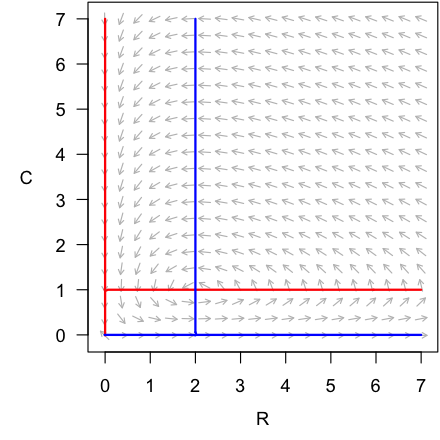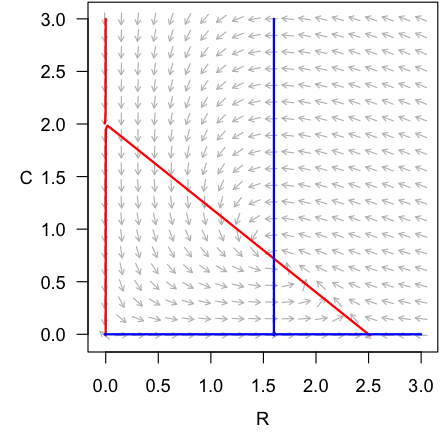class: center, middle, inverse, title-slide .title[ # Predator-prey (consumer-resource) interactions ] .author[ ### Christopher Moore ] .date[ ### Week 06 ] --- class: inverse, center, middle  # Predator-prey (consumer-resource) interactions, example I --- class: inverse, center, middle  --- # Lotka and Volterra - Alfred J. Lotka, American, first proposed predator-prey model in 1910 but more generally in 1925 -- - Vito Volterra, Italian, inspired by fisheries data, published 1926 -- *Lotka-Volterra* is used to describe (nearly) any two-species models, generally; but when used alone it refers to their independently-derived predator-prey model --- # General two-species model `$$\begin{aligned} \frac{dR}{dt} &= f_1(R, C) \\ \frac{dC}{dt} &= f_2(R, C) \end{aligned}$$` -- Predators and prey (consumers and resources) also symbolically represented respectively as `\(V\)` and `\(P\)` (in book; victim and predator), `\(N_1\)` and `\(N_2\)`, and `\(H\)` and `\(P\)` among others. --- # **T**he Lotka-Volterra model We *minimally* have four componenets to add to a model of predator and prey dynamics: -- 1. Prey needs to grow 2. Prey get eaten 3. Predators grow by eating prey 4. Predators must die -- Let's represent these processes using the following -- 1. `\(+rR\)` -- 2. `\(-aRC\)` -- 3. `\(+bRC\)` -- 4. `\(-mC\)` --- # **T**he Lotka-Volterra model Putting the pieces together: 1. Prey growth, `\(+rR\)` 2. Predators removing prey, `\(-aRC\)` 3. Predator growth from eating prey, `\(+bRC\)` 4. Predators die, `\(-mC\)` -- `$$\begin{aligned} \frac{dR}{dt} &= rR - aRC \\ \frac{dC}{dt} &= bRC - mC \end{aligned}$$` -- . . . before we analyze this model, let's consider a simpler, more familiar case between two species --- # Neutralism The case where two species do not affect one another. -- Let's write down the coupled equations for two species, but without interaction, behaving as single species do (logistically). Write each species as `\(N_1\)` and `\(N_2\)`. -- `$$\begin{aligned} \frac{dN_1}{dt} &= r_1N_1 - \alpha _1N_1^2 \\ \frac{dN_2}{dt} &= r_2N_2 - \alpha _2 N_2^2 \end{aligned}$$` or `$$\begin{aligned} \frac{dN_1}{dt} &= r_1N_1\left(\frac{K_1 - N_1}{K_1}\right) \\ \frac{dN_2}{dt} &= r_2N_2\left(\frac{K_2 - N_2}{K_2}\right) \end{aligned}$$` --- # Neutralism time series: code ```r neutralism <- function(t, y, parameters) { N1 <- y[1] N2 <- y[2] r1 <- parameters[1] r2 <- parameters[2] a1 <- parameters[3] a2 <- parameters[4] dN1 <- r1*N1 - a1*N1^2 dN2 <- r2*N2 - a2*N2^2 return(list(c(dN1, dN2))) } n.parms <- c(r1 = 0.55, r2 = 0.5, a1 = 0.02, a2 = 0.01) times <- seq(from = 0, to = 20, by = 0.1) init <- c(N1 = 2, N2 = 0.5) neut.out <- ode(y = init, times = times, parms = n.parms, func = neutralism) ``` --- # Neutralism time series: plot ```r plot(x = neut.out[,1], y= neut.out[,2], lwd = 2, las = 1, xlab = "Time", ylab = "Density", type = "l", ylim = c(0, max(neut.out)), col = "#0000FFFF") lines(x = neut.out[,1], y= neut.out[,3], lwd = 2, col = "red") ``` <!-- --> --- # Neutralism in state space ```r plot(x = neut.out[,2], y= neut.out[,3], lwd = 2, las = 1, xlab = bquote(N[1]), ylab = bquote(N[2]), type = "p", ylim = c(0, max(neut.out)), xlim = c(0, max(neut.out)), col = cp, pch = 16) ``` <!-- --> *dark and light colors respectively correspond to early and later points in time* --- # Neutralism: animated I. Both `\(N_1\)` and `\(N_2\)` below equilibirum <video width="800" height="400" controls loop> <source src="Wk06_PredatorPrey_files/Neutralism.mp4" type="video/mp4"> </video> --- # Neutralism: animated II. `\(N_1\)` below and `\(N_2\)` above their equilibiria <video width="800" height="400" controls loop> <source src="Wk06_PredatorPrey_files/NeutralismII.mp4" type="video/mp4"> </video> --- # Neutralism: animated III. `\(N_1\)` above and `\(N_2\)` below their equilibiria <video width="800" height="400" controls loop> <source src="Wk06_PredatorPrey_files/NeutralismIII.mp4" type="video/mp4"> </video> --- # Neutralism: animated IV. `\(N_1\)` and `\(N_2\)` above their equilibiria <video width="800" height="400" controls loop> <source src="Wk06_PredatorPrey_files/NeutralismIV.mp4" type="video/mp4"> </video> --- # Neutralism: animated All four starting points (initial conditions) showing different behaviours <video width="400" height="400" controls loop> <source src="Wk06_PredatorPrey_files/NeutralismALL.mp4" type="video/mp4"> </video> --- # Nullclines: the trajectory separators **Nullclines** describe the curves (including lines) on a phase plane towards or away from which a populations will grow. This is analagous to the concept of an equilibirum, but on a plane (2 dimensions) populations will grow towards or away from a line instead of a point. -- If we were to plot a logistic-growing population against something arbitrary, like the number of angels dancing on the head of a pin, then we could create a plane that looks something like this: -- <!-- --> --- # Nullclines: the trajectory separators **Nullclines** describe the curves (including lines) on a phase plane towards or away from which a populations will grow. This is analagous to the concept of an equilibirum, but on a plane (2 dimensions) populations will grow towards or away from a line instead of a point. If we were to plot a logistic-growing population against something arbitrary, like the number of angels dancing on the head of a pin, then we could create a plane that looks something like this: <!-- --> --- # Nullclines: the trajectory separators **Nullclines** describe the curves (including lines) on a phase plane towards or away from which a populations will grow. This is analagous to the concept of an equilibirum, but on a plane (2 dimensions) populations will grow towards or away from a line instead of a point. If we were to plot a logistic-growing population against something arbitrary, like the number of angels dancing on the head of a pin, then we could create a plane that looks something like this: <!-- --> --- # Nullclines: the trajectory separators **Nullclines** describe the curves (including lines) on a phase plane towards or away from which a populations will grow. This is analagous to the concept of an equilibirum, but on a plane (2 dimensions) populations will grow towards or away from a line instead of a point. If we were to plot a logistic-growing population against something arbitrary, like the number of angels dancing on the head of a pin, then we could create a plane that looks something like this, **or like this**: <!-- --> --- # Nullclines: the trajectory separators Now, if we had **two** populations/variables (say, `\(N_1\)` and `\(N_2\)`), neither of which are interacting with one another, what would we expect to see? -- <!-- --> --- # Nullclines: the trajectory separators Now, if we had **two** populations/variables (say, `\(N_1\)` and `\(N_2\)`), neither of which are interacting with one another, what would we expect to see, **more simply**? <!-- --> --- # Nullclines: the trajectory separators Now, if we had **two** populations/variables (say, `\(N_1\)` and `\(N_2\)`), neither of which are interacting with one another, what would we expect to see, **more simply**? <!-- --> --- # Nullclines: calculation -- Set `\(\frac{dN_i}{dt} = 0\)` for each equation, put into a graphical form (isolate the variable on the vertical axis), plot, . . . and crush it.  -- Find the nullclines for the neutralism model . . . and plot them (one for each species). --- # Nullclines: calculation The model `$$\begin{aligned} \frac{dN_1}{dt} &= r_1N_1 - \alpha _1N_1^2 \\ \frac{dN_2}{dt} &= r_2N_2 - \alpha _2N_2^2 \end{aligned}$$` -- Setting each subequation to 0 `$$\begin{aligned} 0 &= r_1N_1 - \alpha _1N_1^2 \\ 0 &= r_2N_2 - \alpha _2N_2^2 \end{aligned}$$` -- .pull-left[ For `\(N_1\)` `$$\begin{aligned} N^*_1 &= 0 \\ N^*_1 &= \frac{r_1}{\alpha _1} \end{aligned}$$` ] -- .pull-right[ For `\(N_2\)` `$$\begin{aligned} N^*_2 &= 0 \\ N^*_2 &= \frac{r_2}{\alpha _2} \end{aligned}$$` ] --- # Nullclines: plot your results <!-- --> --- # Nullclines: plot your results <!-- --> --- # Neutralism: using R to graph dynamics We will use a package called `phaseR` that is found in the **C**omprehensive **R** **A**rchive **N**etwork (CRAN). -- You can download pacakges using the function `install.packages(pkgs = )`. Let's `install.packages(pkgs = "phaseR")`. -- Now that it is installed and saved to your personal R library, let's load it: `library(package = "phaseR")`. --- # Neutralism: using R to graph dynamics We have to call (1) `parms`, `parameters` **and** (2) `state`, `y` in our function to play with `phaseR` (it's terrible, I know; I am sincerely sorry) ```r neutralism <- function(t, y, parameters) { N1 <- y[1] N2 <- y[2] r1 <- parameters[1] r2 <- parameters[2] a1 <- parameters[3] a2 <- parameters[4] dN1 <- r1*N1 - a1*N1^2 dN2 <- r2*N2 - a2*N2^2 return(list(c(dN1, dN2))) } init <- c(N1 = 0.1, N2 = 0.05) parm.vals <- c(r1 = 2/3, r2 = 2/3, a1 = 1, a2 = 1) ``` Then, let's plot the nullclines: ```r nullclines(deriv = neutralism, parameters = parm.vals, xlim = c(-0.1, 1), ylim = c(-0.1, 1), add = F) ``` --- # Neutralism: using R to graph dynamics <!-- --> --- # Neutralism: using R to graph dynamics ```r flowField(deriv = neutralism, xlim = c(-0.1, 1), ylim = c(-0.1, 1), parameters = parm.vals, add = F, points = 20) ``` <!-- --> --- # Neutralism: using R to graph dynamics Plotting nullclines and direction field together <!-- --> --- # Neutralism: using R to graph dynamics And if you want, you can add trajectories: ```r trajectory(deriv = neutralism, y0 = init, t.start = 0, t.end = 25, pch = 16) ``` <!-- --> --- # A new model: amensalism **Amensalism**: when one species has a negative effect on another, but that other has no effect on it. A couple biological examples include allelopathy or strong competition. What might the model look like? -- The model `$$\begin{aligned} \frac{dN_1}{dt} &= r_1N_1 - \alpha _1N_1^2 - \beta _1N_1N_2\\ \frac{dN_2}{dt} &= r_2N_2 - \alpha _2N_2^2 \end{aligned}$$` -- Create a phase plane for an amensal relationship between two species. --- # Amensalism The model, initial densities, and parameter values ```r amensalism <- function(t, y, parameters) { N1 <- y[1] N2 <- y[2] r1 <- parameters[1] r2 <- parameters[2] a1 <- parameters[3] a2 <- parameters[4] b1 <- parameters[5] dN1 <- r1*N1 - a1*N1^2 - b1*N1*N2 dN2 <- r2*N2 - a2*N2^2 return(list(c(dN1, dN2))) } init <- c(N1 = 0.1, N2 = 0.05) parm.vals <- c(r1 = 2/3, r2 = 2/3, a1 = 1, a2 = 1, b1 = 0.2) ``` --- # Amensalism The phase plane <!-- --> --- # Amensalism The phase plane .pull-left[ <!-- --> ] .pull.right[ Does this make sense? What are the equations for the nullclines? ] --- # Amensalism The model `$$\begin{aligned} \frac{dN_1}{dt} &= r_1N_1 - \alpha _1N_1^2 - \beta _1N_1N_2\\ \frac{dN_2}{dt} &= r_2N_2 - \alpha _2N_2^2 \end{aligned}$$` -- Setting each subequation to 0 `$$\begin{aligned} 0 &= r_1N_1 - \alpha _1N_1^2 - \beta _1N_1N_2 \\ 0 &= r_2N_2 - \alpha _2N_2^2 \end{aligned}$$` -- .pull-left[ For `\(N_1\)` `$$\begin{aligned} N^*_1 &= 0 \\ N^*_1 &= \frac{r_1 - \beta _1N_2}{\alpha _1} \end{aligned}$$` ] -- .pull-right[ For `\(N_2\)` `$$\begin{aligned} N^*_2 &= 0 \\ N^*_2 &= \frac{r_2}{\alpha _2} \end{aligned}$$` ] --- # Amensalism: varying `\(\beta\)` <video width="500" height="500" controls loop> <source src="Wk06_PredatorPrey_files/Amensalism.mp4" type="video/mp4"> </video> --- # Consumer-resource, both logistic The model with both species growing logistically, but with one species benefiting at the other's expense (say, a consumer-resource interaction) `$$\begin{aligned} \frac{dN_1}{dt} &= r_1N_1 - \alpha _1N_1^2 - \beta _1N_1N_2\\ \frac{dN_2}{dt} &= r_2N_2 - \alpha _2N_2^2 + \beta_21N_1N_2 \end{aligned}$$` --- # Consumer-resource, both logistic The model `$$\begin{aligned} \frac{dN_1}{dt} &= r_1N_1 - \alpha _1N_1^2 - \beta _1N_1N_2\\ \frac{dN_2}{dt} &= r_2N_2 - \alpha _2N_2^2 + \beta_21N_1N_2 \end{aligned}$$` -- Setting each subequation to 0 `$$\begin{aligned} 0 &= r_1N_1 - \alpha _1N_1^2 - \beta _1N_1N_2 \\ 0 &= r_2N_2 - \alpha _2N_2^2 + \beta_21N_1N_2 \end{aligned}$$` -- .pull-left[ For `\(N_1\)` `$$\begin{aligned} N^*_1 &= 0 \\ N^*_1 &= \frac{r_1 - \beta _1N_2}{\alpha _1} \end{aligned}$$` ] -- .pull-right[ For `\(N_2\)` `$$\begin{aligned} N^*_2 &= 0 \\ N^*_2 &= \frac{r_2 + \beta _2N_1}{\alpha _2} \end{aligned}$$` ] --- # Consumer-resource, both logistic If we were to plot these on a graph, with red lines being the nullclines for `\(N_1\)` and the blue lines being the nullclines for `\(N_2\)`, then we'd draw something like this: <!-- --> --- # Consumer-resource, both logistic The model, initial densities, and parameter values ```r cr.log <- function(t, y, parameters) { N1 <- y[1] N2 <- y[2] r1 <- parameters[1] r2 <- parameters[2] a1 <- parameters[3] a2 <- parameters[4] b1 <- parameters[5] b2 <- parameters[6] dN1 <- r1*N1 - a1*N1^2 - b1*N1*N2 dN2 <- r2*N2 - a2*N2^2 + b2*N2*N1 return(list(c(dN1, dN2))) } init <- c(N1 = 0.1, N2 = 0.05) parm.vals <- c(r1 = 2/3, r2 = 2/3, a1 = 1, a2 = 1, b1 = 0.2, b2 = 0.2) ``` --- # Consumer-resource, both logistic The phase plane <!-- --> --- # Consumer-resource, both logistic <video width="800" height="400" controls loop> <source src="Wk06_PredatorPrey_files/CRLog.mp4" type="video/mp4"> </video> --- # C-R/L-V, R ex. growth and C cons. mort This is the Lotka-Volterra predator-prey model: `$$\begin{aligned} \frac{dR}{dt} &= rR - \beta RC\\ \frac{dC}{dt} &= \gamma RC - \delta C \end{aligned}$$` --- # C-R/L-V, R ex. growth and C cons. mort The model `$$\begin{aligned} F_1 = \frac{dR}{dt} &= rR - \beta RC\\ F_2 = \frac{dC}{dt} &= \gamma RC - \delta C \end{aligned}$$` -- Setting each subequation to 0 `$$\begin{aligned} F_1 = 0 &= rR - \beta RC\\ F_2 = 0 &= \gamma RC - \delta C \end{aligned}$$` -- .pull-left[ For `\(F_1\)` `$$\begin{aligned} R^* &= 0 \\ C^* &= \frac{r}{\beta} \end{aligned}$$` ] -- .pull-right[ For `\(F_2\)` `$$\begin{aligned} C^* &= 0 \\ R^* &= \frac{\delta}{\gamma} \end{aligned}$$` ] --- # C-R/L-V, R ex. growth and C cons. mort If we were to plot these on a graph, with red lines being the nullclines for `\(R\)` and the blue lines being the nullclines for `\(C\)`, then we'd draw something like this: .pull-left[ <!-- --> ] -- .pull-right[ <!-- --> ] --- # C-R/L-V, R ex. growth and C cons. mort The model, initial densities, and parameter values ```r cr.LV <- function(t, y, parameters) { R <- y[1] C <- y[2] r <- parameters[1] a <- parameters[2] b <- parameters[3] m <- parameters[4] dR <- r*R - a*R*C dC <- b*R*C - m*C return(list(c(dR, dC))) } init <- c(0.3, 0.5) parm.vals <- c(r = 0.5, a = 0.5, b = 0.25, m = 0.5) ``` --- # C-R/L-V, R ex. growth and C cons. mort The phase plane <!-- --> --- # C-R/L-V, R ex. growth and C cons. mort <video width="800" height="400" controls loop> <source src="Wk06_PredatorPrey_files/CRLV_old.mp4" type="video/mp4"> </video> --- class: inverse, center background-image: url(http://www2.nau.edu/lrm22/lessons/predator_prey/hare_lynx_graph.png) background-size: contain # Snowshoe hare-lynx data from the Hudson Bay Trapping Company --- # C-R, R log. growth and C cons. mort. This is the Lotka-Volterra predator-prey model with generalist prey: `$$\begin{aligned} \frac{dR}{dt} &= rR - \alpha R^2 - \beta RC\\ \frac{dC}{dt} &= \gamma RC - \delta C \end{aligned}$$` --- # C-R, R log. growth and C cons. mort. The model `$$\begin{aligned} F_1 = \frac{dR}{dt} &= rR - \alpha R^2 - \beta RC\\ F_2 = \frac{dC}{dt} &= \gamma RC - \delta C \end{aligned}$$` -- Setting each subequation to 0 `$$\begin{aligned} F_1 = 0 &= rR - \alpha R^2 - \beta RC\\ F_2 = 0 &= \gamma RC - \delta C \end{aligned}$$` -- .pull-left[ For `\(F_1\)` `$$\begin{aligned} R &= 0 \\ R &= \frac{r - \beta C}{\alpha} \end{aligned}$$` ] -- .pull-right[ For `\(F_2\)` `$$\begin{aligned} C &= 0 \\ R &= \frac{\delta}{\gamma} \end{aligned}$$` ] --- # C-R, R log. growth and C cons. mort. The model, initial densities, and parameter values ```r cr.LVDD <- function(t, y, parameters) { R <- y[1] C <- y[2] r <- parameters[1] alpha <- parameters[2] a <- parameters[3] b <- parameters[4] m <- parameters[5] dR <- r*R - alpha*R*R - a*R*C dC <- b*R*C - m*C return(list(c(dR, dC))) } init <- c(0.3, 0.5) parm.vals <- c(r = 0.5, alpha = 0.2, a = 0.25, b = 0.25, m = 0.4) ``` --- # C-R, R log. growth and C cons. mort. The phase plane <!-- --> --- # C-R, R log. growth and C cons. mort. <video width="800" height="400" controls loop> <source src="Wk06_PredatorPrey_files/CRLVDD.mp4" type="video/mp4"> </video>